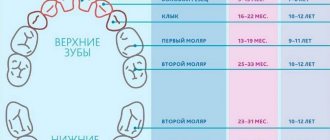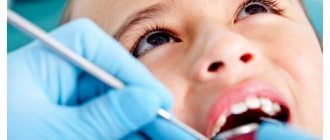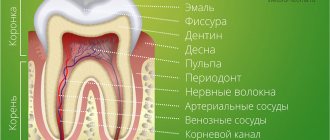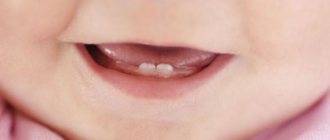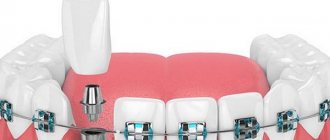It is believed that at the age of 6-7 years the first milk teeth (lower central incisors) should fall out, and at the same time the first permanent molars grow. But what if the pattern breaks down? Can the upper incisors fall out first or, for example, first the lateral and then the central incisors? What could this mean, and should parents pay special attention to this?
What if my teeth fell out too early? Or did the molars start growing before the incisors fell out? Is it normal for molars to start growing at 4-5 years of age? With what it can be connected? When should a situation alert parents?
Why are the first teeth called baby teeth?
There are several opinions on this matter. Doctors attribute the authorship of the term to Hippocrates, who believed that these teeth are formed from mother's milk. Philologist N.N. Vashkevich states that “the term is a tracing from the Latin lactose “milk”. But the tracing paper is false, it is a misunderstood Arabic liwaqt - “for a while,” “temporary.”
One way or another, the first teeth actually actively “feed” on breast milk, since it is from it that the child absorbs the main building material of teeth and bones – calcium. And although baby teeth erupt, as a rule, at 6-7 months, their formation in the child’s jaws occurs long before that.
It is worth noting that for the health and strength of the first teeth, it is mother’s milk (not cow’s) that is necessary, since the nutrients from it are maximally absorbed by the baby’s body. Therefore, the universal recipe “breastfeed your baby” will help in this matter.
When do baby teeth appear?
The rudiments of baby teeth appear in the embryo at about 5-7 weeks of pregnancy. By the time a child is born, the crowns of 10 temporary and 8 permanent teeth have already been formed in his jaws. The timing of the eruption of baby teeth is quite arbitrary. The average formula is as follows: the child’s age in months minus 6. That is, the first 2 teeth (usually the lower middle incisors) appear at 6-7 months, the next 2 (upper middle incisors) at 8-9 months. Next, the upper lateral incisors usually come out, then the lower lateral incisors, then the front molars, canines, and back molars. Thus, by the age of 2-2.5 years, the child should have all 20 milk teeth. These are ideal timing and ideal sequence; deviations from them are quite common. Teeth may begin to appear as early as 4 months, or may linger for up to 8-9 months. In rare cases, a baby is born with teeth already erupted.
If your little one doesn’t “meet the deadline,” don’t be alarmed. This does not mean that the child is developmentally delayed. You should also not be proud of the early appearance of teeth - it does not indicate the child’s superpowers. Early or late appearance of teeth may be a hereditary factor. In case of a strong deviation from the schedule - the appearance of teeth before 4 months or their absence after 9 months - just show the baby to the pediatric dentist. In general, the first examination by a pediatric dentist should be scheduled at least when the child is one year old. The doctor will see how the teething process is progressing and talk with you about the baby’s oral hygiene. The baby will get acquainted with the environment of the office, with the doctor, will get the first positive experience of visiting the dentist, because nothing unpleasant awaits him during this visit, and funny pictures on the walls of the clinic, toys, a chair in which he can ride with his mother - all this will certainly have an impact on him. him a good impression. From now on, you should take your child to the pediatric dentist at least twice a year.
Permanent teeth appeared too early or late
It should be noted that due to the manifestation of acceleration processes, the timing of the eruption of permanent teeth has changed somewhat. Permanent teeth began to emerge earlier, at least 6-8 months. Often, already at the age of five, a child has a mixed dentition, in which the first permanent molars and central incisors are already emerging.
The timing of teething is influenced by both local and general factors.
Local:
- injury,
- premature removal of a temporary tooth,
- edentia,
- tooth retention,
- congenital clefts.
If there is no germ of a permanent replacement tooth or if its position is incorrect, there is no pressure on the bone septum separating it from the roots of the temporary tooth. This leads to a lack of activity of osteoclasts, the cells responsible for root resorption.
Are common:
- heredity,
- genetic factors
- endocrine pathology
- general health.
In particular, with diseases of the thyroid gland, as a result of an imbalance in the mineral balance in the body, there is a delay in the eruption of teeth, both temporary and permanent occlusion. Thus, with hypothyroidism, there is a delay in the eruption of milk teeth by 1-2 years, permanent teeth by 2-3 years.
In general, more and more pediatric dentists and pediatricians are noticing significant differences in the timing and sequence of teeth eruption of temporary and permanent dentition in children. Teething is a multifactorial process. The timing of teething is influenced by race and the general health of the body. None of the currently existing theories fully provides an answer to the mechanisms of teething.
Indisputable, according to many domestic and foreign pediatric dentists, is the fact that the eruption of both temporary and permanent teeth in today’s generation of children occurs earlier than average by at least 6-8 months.
Regular dental checkups will help you avoid serious dental problems.
The pediatric dentist and orthodontist closely monitor the development of the child’s dental system, providing timely assistance if necessary. March 19, 2022
My baby is teething - how can I help him?
The child's profuse salivation will tell you that the first tooth is on the way. 1-2 months before the first tooth erupts, the baby’s saliva begins to flow so actively that it is already difficult to do without aprons and bibs.
All your older relatives will probably tell you about the unpleasant side effects of teething. However, there are many misconceptions here.
The very first teeth usually come out painlessly. What most often happens is this: while spoon-feeding a child, the mother hears the sound of metal on the edge of a tooth - that is, she detects an event that has already happened, without even noticing anything unusual in the child’s behavior.
The emergence of canines and molars may be more difficult. The baby may be capricious, refuse to eat, sleep poorly, and put everything in his mouth. You should take care of inflamed gums - regularly treat them with special gels, offer your child to chew a cooling ring (cold relieves pain well).
However, do not believe that an increase in temperature is associated with teething. Fever and catarrhal symptoms are caused by an infection that is “caught” by the child’s body, weakened by malnutrition and lack of sleep. That is why, during the period of teething, it is better to protect the baby from communicating with strangers. Digestive disorders, an upset stomach of a child at the time of teething, is associated with his desire to chew and suck everything he can reach, just to relieve discomfort in the gums. This is how pathogenic microbes enter his mouth. Try to surround your child with clean objects, wash his hands and toys more often. Regularly let your baby chew small pieces of solid food - dried bread, bagel, apple slice, etc. This will help the teething of those teeth that are already “on the way”, improve blood supply, and therefore nutrition of the gums, develop the chewing reflex, and help the formation of the speech apparatus.
When should you start brushing your child's teeth?
Now pediatric dentists are inclined to believe that systematic cleansing of a child’s oral cavity should begin... from the first days of his life. After feeding, you need to take clean gauze or a bandage, wrap it around your finger, moisten it with boiled water and rub it over the newborn’s gums. This is how you can avoid such major troubles as, for example, oral candidiasis (thrush).
Cleaning the first teeth can be done with a cotton swab or fingertip. You should start using toothpaste and brushing at 12-14 months. Almost all children's brushes are now made from soft artificial bristles, but still be careful and check the brush you like: what age it is designed for, and whether it is soft enough. Give preference to products from well-known manufacturers. Toothpaste also differs in composition and taste depending on the age of the children for whom it is intended. The child should be explained that toothpaste should be spat out, even though it is sweet. However, keep in mind: nothing bad will happen if a child swallows a certain amount of paste at first: manufacturers are aware of this tendency of children and make children's pastes safe for the body.
Of course, it is necessary to involve the child in the dental care process as much as possible: show how to use a brush correctly, brush your teeth in the presence of the child, thereby demonstrating how important this procedure is. You can involve your baby in the process of choosing toothpaste and brush, especially since the brush needs to be changed every 3 months. A slightly older child can be asked to choose brushes for the whole family. It is necessary to develop in your child the skill of regular brushing of teeth 2 times a day. More attention should be paid to brushing your teeth at night. And yet, you can let go of the situation and leave the child to his own devices in matters of oral hygiene only when the child turns 10 years old.
Contraindications for tooth root resection
The operation of resection of the apex of the tooth root is not performed:
- If the patient has a disease such as periodontal disease, which has led to exposure of the neck or root of the tooth;
- If severe tooth mobility is detected;
- For acute periodontitis;
- In case of severe destruction of a diseased tooth;
- In case of an inflammatory process that has damaged most of the root system of the tooth.
The operation of tooth root resection is not prescribed for patients suffering from severe pathologies of the cardiovascular system; other surgical techniques are chosen to remove cysts and granulomas larger than 10 millimeters in size.
Before such a serious and complex operation as resection of the apex of a tooth root, a thorough and high-quality diagnosis is essential, helping to eliminate all possible contraindications to the technique. In our dentistry "Firadent", the highest attention is always paid to the quality of patient diagnostics; all activities are carried out using modern and ultra-precise equipment.
Resection of the apex of the tooth root is an operation carried out in four successive stages, and below we will tell you in detail about all stages of the treatment process.
Diseases of baby teeth
The most common troubles are caries (including bottle caries), pulpitis, periodontitis.
You should be alerted to any changes in the color of the enamel, spots, dots (both dark and white) on the child’s teeth, redness or swelling of the gums. But you don’t have to be afraid of uneven teeth at first: when chewing solid food, the baby teeth will move a little and gradually take the right place.
The causes of diseases in primary teeth are not very different from the causes of problems with permanent teeth. This:
- insufficient care for them (lack of proper hygiene),
- eating disorders,
- undermining of the immune system due to other diseases and taking certain medications.
It is a mistake to think that you can't take too much care of your baby teeth because they will fall out anyway. A diseased tooth in the mouth is a breeding ground for pathogenic bacteria, which not only destroy other teeth, but also negatively affect digestion and ENT organs. A prematurely lost baby tooth is also a problem, as it does not allow the baby to fully chew food or articulate sounds well. In addition, neighboring teeth try to occupy the vacated space - they move. And when a permanent tooth begins to grow here, it simply does not have enough space in the dentition and will have to grow sideways. That’s why it’s imperative to keep an eye on your baby teeth and treat them on time!
We ourselves, out of ignorance, introduce some pathogenic bacteria into the baby’s oral cavity. Suffice it to remember my grandmother’s method of disinfecting a fallen pacifier: lick it and put it in the baby’s mouth. How many times have we done this? Did you feed the child with your spoon? Did you take turns biting an apple or a bun with him? Imagine for a moment the state of your teeth and the newly formed, not fully formed, delicate teeth of the child. What danger did you expose them to?
Foreign microflora is especially harmful to a child under 2 years of age, while temporary teeth are maturing in his mouth and their enamel is very vulnerable.
Leftover food also contributes to the rapid proliferation of bacteria in the oral cavity. A by-product of their activity is acid, which eats away the enamel of a baby tooth, leaving its delicate base - dentin - without protection. Then it’s a matter of little things: microorganisms penetrate the dentin and destroy it. This is how caries occurs. Outwardly, a diseased tooth may look normal for quite some time: a small black dot (the site of the lesion) is not too noticeable. But inside it can already be severely damaged, since caries of baby teeth, due to the softness of their tissues, develops much faster than permanent teeth.
There is also the so-called “bottle caries” - this is a brownish plaque on the front teeth. It is very resistant and cannot be cleaned with a brush. Such teeth rot quickly. This caries is called “bottle caries” because it is a consequence of feeding the baby from a bottle with sweet drinks and juices at night and throughout the night. Carbohydrates are known to be the best food for bacteria. Receiving such wonderful nutrition, pathogenic bacteria rapidly multiply and take over the entire territory available to them. It will be very difficult to force them to give up their positions. The development of “bottle caries” is also facilitated by the fact that at night the natural protector and cleaner of teeth – saliva – is almost not produced. While you are sleeping peacefully, your baby’s fragile little teeth are under powerful attack and are not protected by anything! Is it worth it to buy yourself a vacation at such a price?
Dangerous complications of caries are pulpitis and periodontitis.
Pulpitis is an inflammation of the pulp (the core of the tooth, filled with vessels and nerve fibers). In children, the pulp is practically insensitive, so they may not feel the usual sign of pulpitis - sharp pain. As a result, pulpitis of baby teeth may not be noticed even by an attentive parent, and the role of preventive examinations by a dentist is irreplaceable here.
If bacteria pass through the root of a baby tooth and enter the gum tissue, inflammation begins - periodontitis. Severe pain and fever are already guaranteed here. The gums become red and swollen. Periodontitis is a serious disease, and a child should never be exposed to it.
By visiting your dentist in a timely manner, you can avoid all these troubles. Caries is very easy to treat. Here, however, the first question comes to mind: where exactly to turn. It turns out that the approach to the treatment of baby teeth in different clinics is very different.
Traditionally, caries of primary teeth is treated “in a hurry”: a small child usually does not really want to endure while the doctor picks around his mouth, so the doctor tries to somehow clean the damaged area and fill it with quick-hardening material. As a result, the affected teeth remain untreated and may soon become inflamed again or completely collapse. Sometimes you even have to put crowns on baby teeth.
“The Nutcracker” uses all the possibilities of modern medicine to provide comprehensive care to the smallest patients: from composite materials to “laughing gas” and Sevoran anesthesia. We are convinced that the treatment of primary teeth should be of high quality, and the child’s impressions of the clinic should be the most pleasant.
PsyAndNeuro.ru
Early trauma is adverse events (violence, parental deprivation) that occur in childhood and affect later life. Early trauma is thought to increase the risk of developing mental disorders. However, not all people exposed to adverse childhood experiences develop a mental disorder.
There are sensitive periods in psychomotor development during which the brain is especially plastic. If the time of exposure to unfavorable factors coincides with these periods, then the risk of developing a mental disorder increases. On the other hand, the acquisition of new experiences (including unfavorable ones) during such periods has a protective effect. There is no consensus on this issue; scientific research can support both points of view.
To date, there are no reliable methods for assessing the strength of early trauma. Objective research methods, such as identifying DNA methylation disorders and changes in the functioning of the amygdala, are invasive, expensive and time-consuming.
In March 2022, an article by Kathryn A. Davis and co-authors was published in the journal Biological Psychiatry, dedicated to the search for new methods of assessing early trauma. The researchers suggested that teeth could be used for this purpose, which are a kind of “time capsule” that remains unchanged over the years and is imprinted by the environment. The authors of the article summarized the achievements of dentistry, anthropology and archeology, and studied the results of archaeological studies of the human population and primate populations. The collected data were compared with the latest information about the etiology of mental disorders and the role of early trauma in their development.
There are at least five reasons why teeth were chosen as a marker of early trauma.
Firstly, dental development continues during age-related crises. Mineralization of “baby” teeth begins at the 4th month of intrauterine development and ends by 2–3 years. The formation of permanent second molars lasts from 3 to 14–16 years, and permanent third molars, or “wisdom teeth,” complete their formation by 18–25 years. These periods coincide with sensitive periods of formation of the nervous system.
Secondly, teeth retain “traces” of environmental influences (like rings on trees). Odontoblasts and ameloblasts produce proteins that promote the mineralization of dentin and enamel. Traces of this mineralization are visible during the complete formation of the crown in the form of striated exhaustion, Retzius stripes. It is possible that adverse events occurring during the formation of teeth can affect this process and will be “visible” on the enamel.
Thirdly, during the period of tooth formation, exposure to stress factors such as lack of nutrition, illness, poisoning with toxic substances leads to disturbances in the structure of dentin and enamel hypoplasia. According to some studies, similar changes are found both in living people and in archaeological excavations.
Fourthly, presumably, teeth can “retain” the memory of the effects of stress factors, and the main role in this process is played by the so-called neonatal line - a dark stripe in the enamel of baby teeth. There are several studies that have found a correlation between an increase in its width and stress exposure during the perinatal period. Similar studies were conducted on primates, where separation from the mother, death of a sibling, recovery period after surgery, and change of habitat were used as stress factors. A neonatal stress line was also found in the enamel of primates. The idea that teeth store a biological memory of early trauma is supported by studies demonstrating the effect of stress on the condition of hair and nails, which, like tooth enamel, are formed from ectoderm.
Fifthly, the phases of the “life” of teeth coincide with periods of development of major depressive disorder. Thus, the first teeth begin to fall out at the age of 6 years, in the period preceding puberty, in which, as is known, the risk of developing depression increases. Starting at age 13—the age of possible onset of depressive disorders—teeth can be removed for orthodontic reasons. In late adolescence, third molar extraction may occur. All these teeth can be sent for examination to special laboratories to identify “traces” of early trauma. A similar phase pattern can be observed in relation to other mental disorders.
Based on previous research in the fields of psychiatry, dentistry, archeology and anthropology, the authors of the new paper formed the TEETH (Teeth Encoding Experiences and Transforming Health) model. This model is based on the fact that various stress factors acting in childhood affect the development processes of all organs and systems, including the process of dental development (see diagram).
As a result of the study, three postulates were formulated.
First, impaired brain development and dental growth may be associated with early trauma. The fact is that stress factors acting during the development of the nervous system can leave their “mark” in the structure of the brain. Since the brain and tooth enamel are formed from the ectoderm, it is possible that adversity in childhood leaves an imprint on their structure. For example, enamel defects are observed in Down syndrome and cerebral palsy. Moreover, the authors of the article found a study demonstrating that children with low socioeconomic status and decreased salivary cortisol levels have thinner enamel than their advantaged counterparts.
Secondly, exposure to adverse environmental factors at the time of teeth formation can leave a long-term imprint on them, which can later be seen and objectively measured. Pre- and postnatal damage disrupts both the structure (decreased cortical thickness) and function of the brain (decreased activity of the amygdala). The response to stress changes, which is likely due to changes in cortisol levels. Researchers suggest that stress-induced defects in tooth formation are detected in macro signs of damage, such as changes in tooth size, and micro signs, such as changes in the structure and chemical composition of teeth, manifested in the formation of stress lines in the enamel. Since we know the stages of dental development, these signs can be used to trace the time of exposure to a stress factor: macro signs can indicate the presence of early trauma with an accuracy of three to five years, and micro signs with an accuracy of one week.
Thirdly, disturbances in the development of the nervous system can lead to mental disorders. Previously, scientists in their research relied on studying the brain and the level of stress neurotransmitters as markers of the risk of developing psychopathological symptoms. The authors of the new study found at least eight articles describing the effects of various environmental factors on teeth.
To date, the TEETH model has not been tested on a large number of respondents. Despite this, if we continue research in this direction, then perhaps in the future we will have a simple, non-invasive way to diagnose the risk of developing mental disorders.
Author of the translation: Wirth K.O.
Source: Kathryn A. Davis, Rebecca V. Mountain, Olivia R. Pickett, Pamela K. Den Besten, Felicitas B. Bidlack, and Erin C. Dunn. Teeth as Potential New Tools to Measure Early-Life Adversity and Subsequent Mental Health Risk: An Interdisciplinary Review and Conceptual Model. Biological Psychiatry.
What should you do to keep your baby teeth healthy?
Let’s summarize all those simple and, in general, obvious rules that will help us preserve the baby’s healthy baby teeth given by nature throughout the entire period of their functioning and not lead to the moment when the child’s baby tooth hurts or its premature loss occurs.
- Avoid unnecessary use of medications during pregnancy and breastfeeding to avoid damaging developing teeth.
- Eat right during pregnancy.
- Feed your baby breast milk.
- Introduce solid foods into your child's diet in a timely manner.
- Do not share food with your child (especially before the age of two), and do not lick his pacifier for the purpose of “disinfection.”
- Don't let your child fall asleep with a bottle of sugary drink.
- Carefully monitor your child’s oral hygiene from the first days of life.
- Have your child undergo regular preventive examinations with a pediatric dentist.
What is tooth root resection, indications and contraindications for surgery
Resection of the apex of the tooth root or apexectomy is a surgical procedure during which part of the tooth root is removed. When performing a tooth resection, only the inflamed and infected part of the root is removed, healthy tissue is not affected. To speed up the process of restoration of tooth tissue after root resection, a special bone material is placed in place of the removed fragment.
Tooth resection must be performed by a competent and experienced dental surgeon, since this operation is a complex surgical procedure. Due to the complexity and the fact that the surgeon will have to cut through the gum and work with the jaw bone to gain access to the root of the tooth, root resection surgery is always performed under anesthesia - local or general.
In our dental clinic in Moscow - “Firadent”, patients are offered the service of performing an operation to resection the apex of the tooth root under sedation, that is, in a state of light medicated sleep. You will sleep, and the doctor will do all the work and cure your bad tooth. Sedation allows you to completely eliminate stress and pain during dental treatment!
Naturally, such a complex operation as resection of the apex of a tooth root is not carried out just like that; there must be certain indications for the intervention. Tooth root resection is prescribed for:
- The need to remove pathological neoplasms on teeth with installed core inlays and pins;
- Resection of the tooth under the crown is relevant. This way, you can save the tooth, provide it with high-quality treatment, and at the same time not remove the installed prosthesis;
- Inability to carry out high-quality filling of dental canals (for example, in case of their abnormal obstruction) or to unfill tooth canals that were treated previously.
It is the resection of the tooth root that allows you to save the tooth from removal due to cysts and other large tumors. However, there is a fairly extensive list of contraindications for this operation, which are important to consider when planning treatment.


